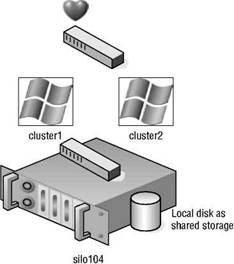Книга: Mastering VMware® Infrastructure3
Cluster-in-a-Box
Cluster-in-a-Box
The cluster-in-a-box scenario involves configuring two virtual machines hosted by the same ESX Server as nodes in a server cluster. The shared disks of the server cluster can exist as .vmdk files stored on local VMFS volumes. Figure 10.3 details the configuration of a cluster-in-a-box scenario.
After reviewing the diagram of a cluster-in-a-box configuration, you might wonder why you would want to deploy such a thing. The truth is, you wouldn't want to deploy cluster in a box because it still maintains a single point of failure. With both virtual machines running on the same host, if that host fails, both virtual machines fail. This architecture contradicts the very reason for creating failover clusters. A cluster-in-a-box still contains a single point of failure that can result in downtime of the clustered application. If the ESX Server hosting the two-node cluster-in-a-box fails, then both nodes are lost and a failover does not occur. This setup might, and I use might loosely, be used only to "play" with clustering services or to test clustering services and configurations. But ultimately, even for testing, it is best to use the cluster-across-boxes to get a better understanding of how this might be deployed in a production scenario.

Figure 10.3 A cluster-in-a-box configuration does not provide protection against a single point of failure. Therefore, it is not a common or suggested form of deploying Microsoft server clusters in virtual machines.
Cluster-in-a-Box
As suggested in the first part of this chapter, server clusters are deployed for high availability. High availability is not achieved using a cluster-in-a-box, and therefore this configuration should be avoided for any type of critical production applications and services.
- Clustering Virtual Machines
- Cluster-Across-Boxes
- CLUSTERIP target
- 2.12 Оконные менеджеры «BlackBox» и «FluxBox»
- Chapter 11. BusyBox
- Appendix C. BusyBox Commands
- 11.1. Introduction to BusyBox
- 11.1.1. BusyBox is Easy
- 11.2. BusyBox Configuration
- 11.2.1. Cross-Compiling BusyBox
- 11.3. BusyBox Operation
- 11.3.1. BusyBox Init




